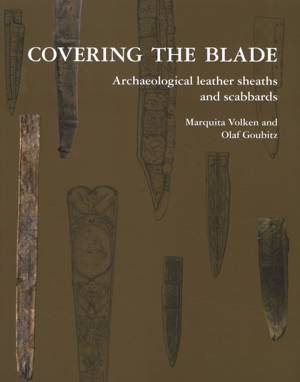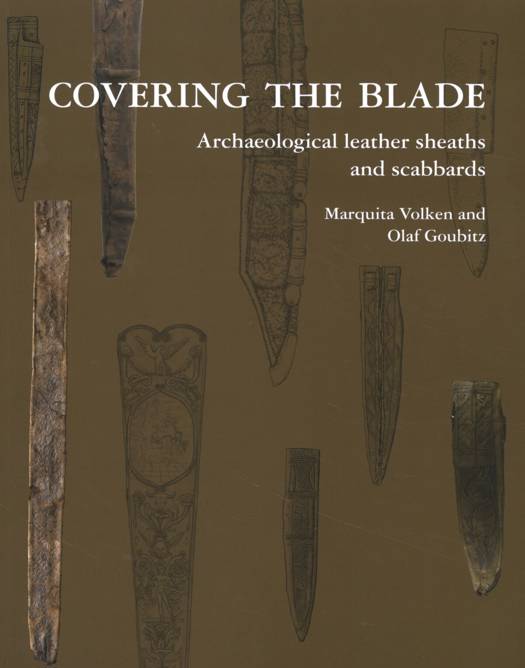
En raison d'une grêve chez bpost, votre commande pourrait être retardée. Vous avez besoin d’un livre rapidement ? Nos magasins vous accueillent à bras ouverts !
- Retrait gratuit dans votre magasin Club
- 7.000.000 titres dans notre catalogue
- Payer en toute sécurité
- Toujours un magasin près de chez vous
En raison de la grêve chez bpost, votre commande pourrait être retardée. Vous avez besoin d’un livre rapidement ? Nos magasins vous accueillent à bras ouverts !
- Retrait gratuit dans votre magasin Club
- 7.000.0000 titres dans notre catalogue
- Payer en toute sécurité
- Toujours un magasin près de chez vous
Covering the Blade
Archaeological Leather Sheaths and Scabbards
Marquita Volken, Olaf Goubitz
Livre broché | Anglais
34,95 €
+ 69 points
Description
Since 1968 several thousand leather artefacts have been recovered in the city of Dordrecht, ranging in date from the 12th century through to the 17th century. At that time, Olaf Goubitz was employed at the Rijksdienst voor Oudheidkundig Bodemonderzoek (ROB) and was able to devote his time to the leather and thus the organic conservation lab was established. Over the years the quantity and importance of the Dordrecht archaeological leather finds made it obvious they certainly merited publication. In 2002 the leather footwear from Dordrecht and other sites was presented in Stepping Through Time. A chapter on Roman footwear by Carol van Driel-Murray and the Prehistoric footwear by Willy Groenman-van Waateringe completed the chronological range. The archaeological leather purses, bags and other small containers from Dordrecht and other sites appeared in Purses in Pieces in 2007.
The third book was to cover the knife sheaths and sword scabbards from Dordrecht, numbering more than 300 to date. Goubitz had already begun to draw the decorated knife sheaths from Dordrecht that passed through his hands.
The Medieval archaeological leather sheath and scabbard finds from the city of Dordrecht form the core collection for this volume, the third in the trilogy after Stepping Through Time and Purses in Pieces. It was finished by Marquita Volken.
As with the previous volumes, a wider picture is presented, thus incorporating chapters on Prehistoric, Roman, and modern period sheaths and scabbards from other sites in the Netherlands and Europe. Sheaths and scabbards are covers for blades, so here scissors, agricultural tools and specialized knives are included along with knives, daggers, and swords. The aim, apart from presenting the Dordrecht collection, is also to provide a framework for research: chronology, typology, decoration styles, plus accessory items like suspension methods, cover-guards and handle grips in leather. A useful research technique for understanding a leather archaeological object is to reconstruct it. A select number of sheaths and scabbards have been reconstructed, providing insights on construction, decoration, and functional aspects.
Few prehistoric knife sheaths are known in archaeology due to the rare survival of organic materials. Frozen or very dry, stable environments also preserve organic material but so far the only prehistoric sheath to have been found in ice is the grass sheath from the Iceman.
Here is a selection of the sheaths and scabbards of which you can find a reconstruction in chapter 9 of Covering the Blade:
- An Early Bronze Age ceremonial axe and leather case come from Ireland. It was discovered in a peat bog at Brockagh, Co. Kildare.
- From the Dutch site at Kessel on the Rhine-Meuse Delta the finds of La Tène period swords and sheaths are the remains of a battle between the Batavians and Roman forces. Of the 22 swords recovered four were still in their scabbards.
- The Merovingian finds from tomb 11 at the Cathedral of Saint-Denis FR included fragments of a small edge-seamed knife sheath with an attached case for the wood pick.
- A decorated leather scabbard cover from Groningen NL, is the source for the hypothetical reconstruction of a seax scabbard.
- A thirteenth century sword and scabbard have been preserved as the relics of Saint Maurice, a third century military leader martyred at Agaunum (present day Saint-Maurice, Switzerland). The scabbard has a wood core made of two laths shaped to the blade.
- The upper section of a narrow fourteenth century hunting sword scabbard cover from Dordrecht is the model for this reconstruction. The scabbard has a peaked mouth, a reinforcement collar and a centre back closed seam.
- The fourteenth century decorated scabbard from Leiden found with 137 other sword scabbards at the Marktenroute site, Leiden, a fourteenth century decorated leather scabbard cover is one of 28 examples decorated by creasing.
- A fourteenth century leather scabbard cover from the Statenplein site, Dordrecht NL, is source for this reconstruction.
- The nearly complete leather scabbard cover from the Statenplein site, Dordrecht NL, and the lower section of the same type of scabbard from the Tolbrugstraat site, Dordrecht NL, are the sources for the reconstruction of the falchion scabbard.
- A fourteenth century decorated leather dagger scabbard cover from the Statenplein site, Dordrecht NL, is the source for this reconstruction.
- From the Wood Quay site in Dublin comes an almost complete winged small knife sheath dated from AD 1180-1250. It is decorated with creased motifs front and back.
- The edge-seamed Schleswig knife sheath was fitted with a metal half-chape (absent) and a riveted handle section consisting of five straps through pairs of slits and a fringed re-enforcement band.
- Among the many fourteenth century sheaths from the Statenplein site is one decorated with a two headed beast. The decoration is made with creased lines and the stippled background made with a fragment of a fine-toothed comb.
- A fourteenth century sheath for a large principal knife and a full set of byknives is often called a 'hunting set'. The hunting set sheath found at the Statenplein site at Dordrecht NL had a principal knife, a smaller knife, a honing steel, and a pair of bow spring scissors.
- A fifteenth century fragmented sheath decorated with the apple tree motif from the Tolbrugstraat site at Dordrecht NL is the inspiration for a sheath for a knife and byknife honing steel.
The third book was to cover the knife sheaths and sword scabbards from Dordrecht, numbering more than 300 to date. Goubitz had already begun to draw the decorated knife sheaths from Dordrecht that passed through his hands.
The Medieval archaeological leather sheath and scabbard finds from the city of Dordrecht form the core collection for this volume, the third in the trilogy after Stepping Through Time and Purses in Pieces. It was finished by Marquita Volken.
As with the previous volumes, a wider picture is presented, thus incorporating chapters on Prehistoric, Roman, and modern period sheaths and scabbards from other sites in the Netherlands and Europe. Sheaths and scabbards are covers for blades, so here scissors, agricultural tools and specialized knives are included along with knives, daggers, and swords. The aim, apart from presenting the Dordrecht collection, is also to provide a framework for research: chronology, typology, decoration styles, plus accessory items like suspension methods, cover-guards and handle grips in leather. A useful research technique for understanding a leather archaeological object is to reconstruct it. A select number of sheaths and scabbards have been reconstructed, providing insights on construction, decoration, and functional aspects.
Few prehistoric knife sheaths are known in archaeology due to the rare survival of organic materials. Frozen or very dry, stable environments also preserve organic material but so far the only prehistoric sheath to have been found in ice is the grass sheath from the Iceman.
Here is a selection of the sheaths and scabbards of which you can find a reconstruction in chapter 9 of Covering the Blade:
- An Early Bronze Age ceremonial axe and leather case come from Ireland. It was discovered in a peat bog at Brockagh, Co. Kildare.
- From the Dutch site at Kessel on the Rhine-Meuse Delta the finds of La Tène period swords and sheaths are the remains of a battle between the Batavians and Roman forces. Of the 22 swords recovered four were still in their scabbards.
- The Merovingian finds from tomb 11 at the Cathedral of Saint-Denis FR included fragments of a small edge-seamed knife sheath with an attached case for the wood pick.
- A decorated leather scabbard cover from Groningen NL, is the source for the hypothetical reconstruction of a seax scabbard.
- A thirteenth century sword and scabbard have been preserved as the relics of Saint Maurice, a third century military leader martyred at Agaunum (present day Saint-Maurice, Switzerland). The scabbard has a wood core made of two laths shaped to the blade.
- The upper section of a narrow fourteenth century hunting sword scabbard cover from Dordrecht is the model for this reconstruction. The scabbard has a peaked mouth, a reinforcement collar and a centre back closed seam.
- The fourteenth century decorated scabbard from Leiden found with 137 other sword scabbards at the Marktenroute site, Leiden, a fourteenth century decorated leather scabbard cover is one of 28 examples decorated by creasing.
- A fourteenth century leather scabbard cover from the Statenplein site, Dordrecht NL, is source for this reconstruction.
- The nearly complete leather scabbard cover from the Statenplein site, Dordrecht NL, and the lower section of the same type of scabbard from the Tolbrugstraat site, Dordrecht NL, are the sources for the reconstruction of the falchion scabbard.
- A fourteenth century decorated leather dagger scabbard cover from the Statenplein site, Dordrecht NL, is the source for this reconstruction.
- From the Wood Quay site in Dublin comes an almost complete winged small knife sheath dated from AD 1180-1250. It is decorated with creased motifs front and back.
- The edge-seamed Schleswig knife sheath was fitted with a metal half-chape (absent) and a riveted handle section consisting of five straps through pairs of slits and a fringed re-enforcement band.
- Among the many fourteenth century sheaths from the Statenplein site is one decorated with a two headed beast. The decoration is made with creased lines and the stippled background made with a fragment of a fine-toothed comb.
- A fourteenth century sheath for a large principal knife and a full set of byknives is often called a 'hunting set'. The hunting set sheath found at the Statenplein site at Dordrecht NL had a principal knife, a smaller knife, a honing steel, and a pair of bow spring scissors.
- A fifteenth century fragmented sheath decorated with the apple tree motif from the Tolbrugstraat site at Dordrecht NL is the inspiration for a sheath for a knife and byknife honing steel.
Spécifications
Parties prenantes
- Auteur(s) :
- Editeur:
Contenu
- Nombre de pages :
- 300
- Langue:
- Anglais
- Illustré:
- Oui
Caractéristiques
- EAN:
- 9789089320513
- Date de parution :
- 19-03-21
- Format:
- Livre broché
- Format numérique:
- Trade paperback (VS)
- Dimensions :
- 208 mm x 257 mm
- Poids :
- 1043 g

Les avis
Nous publions uniquement les avis qui respectent les conditions requises. Consultez nos conditions pour les avis.






